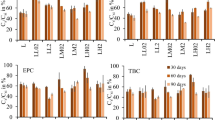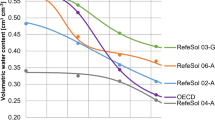Abstract
Our investigation used carbendazim as a representative pesticide for testing an integrated soil microcosm (ISM) test protocol. Microcosms, set up in a greenhouse, consisted of cylinders made from high-density polyethylene (HDPE) pipe, 7.5 cm (i.d.) × 15 cm high. A fine nylon mesh was placed across the bottom of each microcosm for leachate collection. Field soil, (silty clay loam), collected from Flörsheim, Germany, was sieved through a 5 mm screen and mixed thoroughly. Earthworms, enchytraeids, and microarthropods were added to each microcosm. Each microcosm contained five wheat seedlings, and was maintained at a 12 h–12 h light–dark cycle. Artificial rainwater was used to water microcosms as required. Soil microcosms were treated with carbendazim at concentrations 1, 3, 9, 27, and 81 times higher than the predicted environmental concentration (PEC) of 0.76 mg a.i./kg soil dry weight. A water-only control treatment was also used. The key soil processes used as endpoints were microbial activity, nitrogen mineralization, soil enzymatic activity, ammonium and nitrate leaching, organic matter decomposition and biological feeding activity. Key structural parameters measured were microbial biomass, nematode communities, microarthropod populations and diversity, enchytraeid and earthworm populations and plant growth. Pesticide degradation, leaching and uptake into plants and earthworms were also assessed. Carbendazim had significant effects on several key soil processes including soil ammonium-N and nitrate-N concentrations and soil dehydrogenase activity. Wheat growth, nematode and earthworm populations, and invertebrate feeding activity were soil structural parameters affected significantly by carbendazim. Earthworm biomass was the most sensitive parameter measured with an EC50 of 1.9 mg a.i./kg soil dry weight 28 days after treatment. A comparison of these results with results from single-species tests, small microcosms, large terrestrial model ecosystems, and field tests indicated that the ISM protocol may adequately predict environmental effects.
Similar content being viewed by others
References
Anderson, J.P.E. (1982). Soil Respiration. In A.L. Page (ed), Methods of Soil Analysis, Part 2-Chemical and Microbiological Properties, 2nd edn. Agronomy Series No. 9, pp. 831-71. Madison, WI, USA: American Society of Agronomy, Inc., Soil Science Society of America, Inc.
Baermann, G. (1917). Eine einfache Methode zur Auffindung von Ancylostomum (Nematoden) Larven in Erdproben. Geneeskd. Tijdschr. Ned. Indie. 57, 131-7.
Bailey, G.W. and White, J.L. (1964). Review of adsorption and desorption of organic pesticides by soil colloids, with implications concerning pesticide bioactivity. J. Agri. Food Chem. 12, 324-32.
Baker, H.J., Bertus, A.L. and Courtney, G.F. (1976). The uptake of some benzimidazole fungicides from soil into plants and their persistence in soil and plant tissue. Acta Phytopathol. Hun. 11, 331-4.
Baude, F.J., Pease, J.L. and Holt, R.F. (1974). Fate of benomyl on field soil and turf. J. Agri. Food Chem. 22, 413-8.
Ben-Azizz, A. and Aharonson, N. (1974). Dynamics of uptake, translocation, and disappearance of thiabendazole and methyl-2-benzimidazolecarbamate in pepper and tomato plants. Pest. Biochem. Physiol. 4, 120-6.
Berg, B., Berg, M., Box, E., Bottner, P., Breymeyer, A., Calvo de Anta, R., Couteaux, M., Gallardo, A., Escudero, A., Kratz, W., Madeira, M., Malkonen, E., McClaugherty, C., Meentemeyer, V., Munoz, F., Piussi, P., Remacle, J. and Virzo de Santo, A. (1993). Litter mass loss rates in pine forests of Europe and Eastern United States: some relationships with climate and litter quality. Biogeochemistry 20, 127-59.
Bernal, J., Nozal, M., Toribio, L., Jimenez, J. and Atienza, J. (1997). High-performance liquid chromatographic determination of benomyl and carbendazim residues in apiarian samples. Journal of Chromatography 787, 129-36.
Cancela, G.D., Taboada, E.R. and Sanchez-Rasero, F. (1992). Carbendazim adsorption on montmorillonite, peat and soils. J. Soil Science 43, 99-111.
Cook, M.E. and Swait, A.A.J. (1975). Effects of some fungicide treatments on earthworm populations and leaf removal in apple orchards. J. Hortic. Sci. 50, 495-9.
Danielson, R.M. and Davey, C.B. (1973). Carbon and nitrogen nutrition of Trichoderma. Soil Biol. Biochem. 5, 505-15.
Didden, W., Born, H., Domm, H., Graefe, U., Heck, M., Kuhle, J., Mellin, A. and Römbke, J. (1995). The relative efficiency of wet funnel techniques for the extraction of Enchytraeidae. Pedobiologia 39, 52-7.
Edwards, C.A. (1991). The assessment of populations of soilinhabiting invertebrates. In D.A. Jr. Crossley, D.C. Coleman, P.F. Hendrix, W. Cheng, D.H. Wright, M.H. Beare and C.A. Edwards (eds). Modern Techniques in Soil Ecology, pp. 145-77 Amsterdam, The Netherlands: Elsevier.
Edwards, C.A., Subler, S. and Chen, S.K. (1994). A microcosms system for evaluating the effects of pesticides on dynamic soil processes and soil organisms. Proceedings of the Brighton Crop Protection Conference-Pests and Diseases, pp. 1301-6.
Edwards, C.A., Subler, S., Chen, S.K., and Bogomolov, D.M. (1995). Essential criteria for selecting bioindicator species, processes, or systems to assess the environmental impact of chemicals on soil ecosystems. In N.M. Van Straalen and D.A. Krivolutskii (eds). New Approaches to the Development of Bioindicator Systems for Soil Pollution, pp. 67-84 Amsterdam, The Netherlands: Kluwer Academic Publishers. pp. 67-84.
Eisenbeis, G., Lenz, R., Dogan, H. and Schuler, G. (1996). Zur biologischem Aktivität von Nadelwaldboden: Messung der tierischen Fressaktivität mit dem Koderstreifen-Test sowie Bestimmung von Streuabbauraten mit dem Minicontainer-Test. Verh. Ges. Okol. 26, 305-11 (summary in English).
Förster, B., Römbke, J., Knacker, T. and Morgan, E. (1995). Microcosm study of the interactions between microorganisms and enchytraeid worms in grassland soil and litter. Eur. J. Soil Biol. 31, 21-7.
Förster, B., Eder, M., Morgan, E. and Knacker, T. (1996). A microcosm study of the effects of chemical stress, earthworms and microorganisms and their interactions upon litter decomposition. Eur. J. Soil Biol. 32, 25-33.
Gillett, J.W. and Witt, J.M. (1980). Chemical evaluation: projected application of terrestrial microcosm technology. In J.P. Giesy (ed). Microcosms in Ecological Research, pp. 1008-1033 US Dept. of Energy.
Hamilton, M.A., Russo, R.C. and Thurston, R.V. (1977). Trimmed Spearman-Karber method for estimating median lethal concentrations in toxicity bioassays. Environ. Sci. Technol. 11, 714-9. Correction (1978). 12, 417.
Hendrix, P.F., Parmelee, R.W., Crossley, D.A. Jr., Coleman, D.C., Odum, E.P. and Groffman, P.M. (1986). Detritus food webs in conventional and no-tillage agroecosystems. Bioscience 36, 374-80.
Kratz, W. (1992). Ecosystem study in a central European pine forest-studies on the cycling of elements during litter decomposition in pine forests in the Grunewald, Berlin. In A. Teller, P. Mathy and J. Jeffers (eds). Responses of forest ecosystems to environmental changes, pp. 976-7 London, UK: Elsevier Applied Science.
Kratz, W. (1998). The Bait-Lamina Test. Environ. Sci. Pollut. Res. 5, 94-6.
Keogh, R.G. and Whitehead, P.H. (1975). Observations on some effects of pasture spraying with benomyl and carbendazim on earthworm activity and litter removal from pasture. N.Z. J. Exp. Agric. 3, 103-4.
Liu, L.X. and Hsiang, T. (1994). Bioassays for benomyl adsorption and persistence in soil. Soil Biol. Biochem. 26, 317-24.
Lofs-Holmin, A. (1981). Influence in field experiments of benomyl and carbendazim on earthworms (Lumbricidae) in relation to soil texture. Swed. J. Agric. Res. 11, 141-7.
Martikainen, E., Haimi, J. and Ahtiainen, J. (1998). Effects of dimethoate and benomyl on soil organisms and soil processes-a microcosm study. Appl. Soil Ecol. 9, 381-7.
Morgan, E. and Knacker, T. (1994). The role of laboratory terrestrial model ecosystems in the testing of potentially harmful substances. Ecotoxicology 3, 213-33.
Peeples, J.L. (1974). Microbial activity in benomyl-treated soils. Phytopathology 64, 857-60.
Rhodes, R.C. and Long, J.D. (1974). Run-off and mobility studies on benomyl in soils and turf. Bull. Environ. Cont. Toxicol. 12, 385-93.
Roberts, B.L. and Dorough, H.W. (1984). Relative toxicities of chemicals to the earthworm Eisenia foetida. Env. Tox. Chem. 3, 67-78.
Römbke, J., Bauer, C. and Marschner, A. (1996). Hazard assessment of chemicals in soil. Proposed ecotoxicological test strategy. Environ. Sci. Pollut. Res. Int. 3, 78-82.
Römbke, J., Van Gestel, C.A.M., Jones, S.E., Koolhaas, J.E., Rodrigues, J.M.L. and Moser, T. (2004). Ring-Testing and Field-Validation of a Terrestrial Model Ecosystem (TME)-An Instrument for Testing Potentially Harmful Substances: Effects of the model chemical carbendazim on earthworms. Ecotoxicology 13, 105-118.
Sheppard, S.C. (1997). Toxicity testing using microcosms. In J. Tarradellas, G. Bitton and D. Rossel (eds). Soil Ecotoxicology, pp. 345-73. Inc. Boca Raton, FL, USA: CRC Press.
Siegel, M.R. (1975). Benomyl-soil microbial interactions. Phytopathology 65, 219-20.
Sims, G.K., Ellsworth, T.R. and Mulvaney, R.L. (1995). Microscale determination of inorganic nitrogen in water and soil extracts. Commun. Soil Sci. Plant Anal. 26, 303-16.
Stringer, A. and Wright, M.A. (1973). The effect of benomyl and some related compounds on Lumbricus terrestris and other earthworms. Pestic. Sci. 4, 165-70.
Stringer, A. and Wright, M.A. (1976). The toxicity of benomyl and some related 2-substituted benzimidazoles to the earthworm Lumbricus terrestris. Pestic. Sci. 7, 459-64.
Tabatabai, M.A. (1982). Soil enzymes. In: A.L. Page (ed). Methods of Soil Analysis, pp. 903-47. Part 2-Chemical and Microbiological Properties, 2nd edn. Agronomy Series No. 9, Madison, WI, USA: American Society of Agronomy, Inc., Soil Science Society of America, Inc.
Van Gestel, C.A.M. (1992). Validation of earthworm toxicity tests by comparison with field studies: A review of benomyl, carbendazim, carbofuran, and carbaryl. Ecotox. Environ. Safety 23, 221-36.
Van Gestel, C.A.M., Dirven-Van Breemen, E.M., Baerselman, R., Emans, J.J.B., Janssen, J.A.M., Postuma, R. and Van Vliet, P.J.M. (1992). Comparison of sublethal and lethal criteria for nine different chemicals in standardized toxicity tests using the earthworm Eisenia andrei. Ecotox. Environ. Safety 23, 206-20.
Van Gestel, C.A.M., Koolhaas, J.E., Schallnass, H.J., Rodrigues, J.M.L. and Jones, S.E. (2004). Ring-Testing and Field-Validation of a Terrestrial Model Ecosystem (TME)-An Instrument for Testing Potentially Harmful Substances: Effects of the model chemical carbendazim on nutrient cycling. Ecotoxicology 13, 119-128.
Van Voris, P., Tolle, D.A., Arthur, M.F. and Chesson, J. (1985). Terrestrial Microcosms: Applications, Validation and Cost-Benefit Analysis. In C.H. Ward and Walton, B.T. (eds). Multispecies Toxicity Testing, pp. 117-142 New York, NY, USA: Pergamon Press.
Velthorst, E.J. (1993). Manual for chemical water analysis, Department of Soil Science and Geology, Agricultural University, Wageningen, The Netherlands.
Vink, K. and Van Straalen, N.M. (1999). Effects of benomyl and diazinon on isopod-mediated leaf litter decomposition in microcosms. Pedobiologia 43, 345-59.
Von Törne, E. (1990). Assessing feeding activities of soil-living animals. I. Bait-lamina tests. Pedobiologia, 34, 89-101.
Wainwright, M. and Pugh, G.J.F. (1974). The effects of fungicides on certain chemical and microbial properties of soils. Soil Biol. Biochem. 6, 263-7.
Wright, M.A. (1977). Effects of benomyl and some other systemic fungicides on earthworms. Ann. Appl. Biol. 87, 520-4.
Wright, M.A. and Stringer, A. (1973). The toxicity of thiabendazole, benomyl, methyl benzimidazol-2-yl carbamate and thiophanate-methyl to the earthworm Lumbricus terrestris. Pestic. Sci. 4, 431-2.
Yarden, O., Aharonson, N. and Katan, J. (1987). Accelerated microbial degradation of methyl-benzimidazol-2-ylcarbamate in soil and its control. Soil Biol. Biochem. 19, 735-9.
Yarden, O., Gamliel, A., Aharonson, N. and Katan, J. (1989). Solarization enhances dissipation of carbendazim (MBC) in soil. Soil Biol. Biochem. 21, 857-61.
Yarden, O., Salomon, R., Katan, J. and Aharonson, N. (1990). Involvement of fungi and bacteria in enhanced and nonenhanced biodegradation of carbendazim and other benzimidazole compounds in soil. Can. J. Microbiol. 36, 15-23.
Author information
Authors and Affiliations
Corresponding author
Rights and permissions
About this article
Cite this article
Burrows, L.A., Edwards, C.A. The Use of Integrated Soil Microcosms to Assess the Impact of Carbendazim on Soil Ecosystems. Ecotoxicology 13, 143–161 (2004). https://doi.org/10.1023/B:ECTX.0000012411.14680.21
Issue Date:
DOI: https://doi.org/10.1023/B:ECTX.0000012411.14680.21




